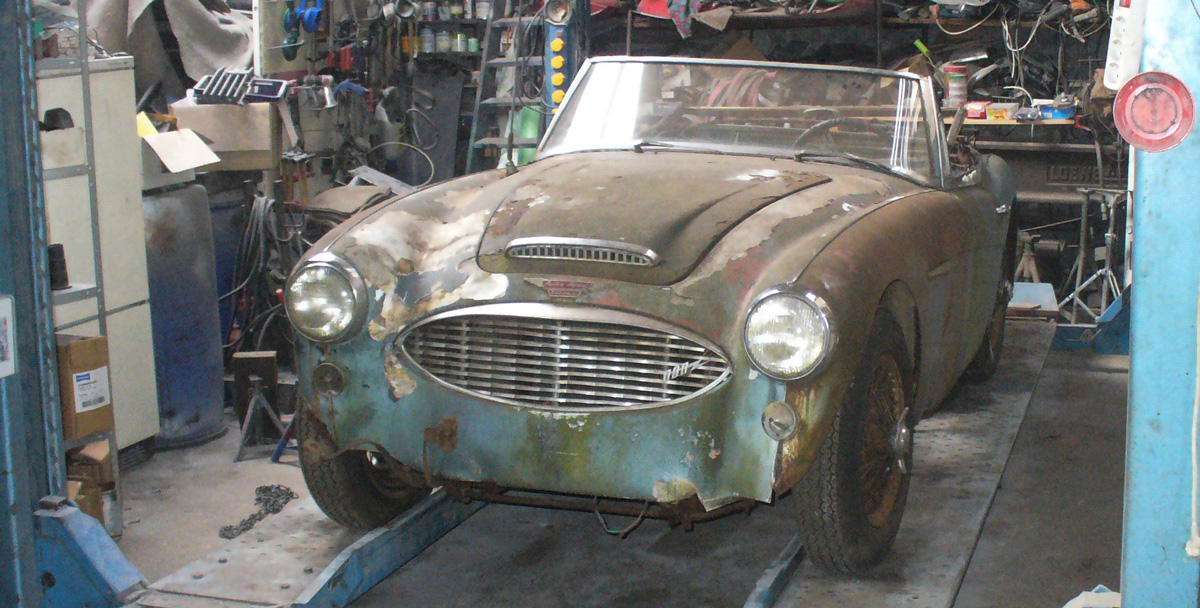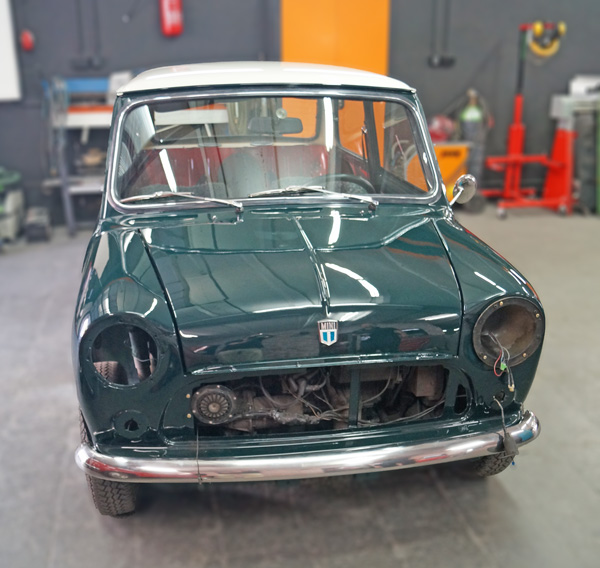Classic car restoration

Position: Sale
Updated: 25.10.2023

Refreshing, complete or partial restoration?
A restoration is a true-to-the-original repair of an object down to the last detail. And depending on the age and condition of your classic car, a refreshment or partial restoration can be enough to make it fit again. In the case of major defects, such as severe rust, you must then consider whether a complete restoration is necessary so that your classic car can once again shine in all its glory.
In this process, the classic car can either be subjected to a rolling restoration, in which only various individual parts are worked on and the car remains completely usable. Or a frame-off restoration is carried out, in which your car is dismantled into its individual parts and thus all bodywork and interior parts can be overhauled.
The most important thing is that your car is inspected by a competent person who can assess as accurately as possible which type of restoration is the most suitable for your classic car. If spare parts are needed, we advise you to always opt for original spare parts.
Because anything else would save money at the moment, but unnecessarily reduce the value of your car or even lead to the loss of classic car status!

Classic car restoration: Step by step to new splendour
When it makes sense to restore your classic car depends partly on the law, your ideas, the general condition and the age of your car. Regardless of the extent to which your classic car is in need of restoration, numerous workshops throughout Germany offer professional restoration of your car.
Here you are not only optimally advised, you also always receive a cost estimate and the employees in such businesses have exactly the necessary level of craftsmanship, experience and creativity that a classic car restoration requires. And the older and rarer a classic car is, the more complex - in terms of cost and duration - a restoration is.
To give you an idea of how much work is involved in the professional restoration of historic vehicles, we have listed a few standard building points for classic car restoration. Concrete restoration work is only ever planned at any professional workshop after a precise appraisal and inventory of your vehicle!
Bodywork
When a complete restoration is necessary, your classic car is stripped to the bone, so to speak. This begins with the dismantling of the vehicle, whereby all parts are examined for their further use and either inserted into the repair cycle or stored dust-free and protected. It is essential to remove sealant and insulating material from around the bodywork so that the sandblasting. The underbody protection must also be removed beforehand! This way, the blasting material also removes the last paint residues on the car.
This allows the completely stripped bodyshell to be inspected for rust or other damage. After that, the restorer can make an exact inventory, plan repairs and, if necessary, order suitable spare parts. Basically, the procurement of spare parts is the linchpin of every classic car restoration. Therefore, it should be said once again: Pay particular attention to expert advice, high availability and good quality of the parts!
Bodywork repair: sheet metal work and fabrication of sheet metal parts
Here, the bodywork is still taken care of: Whether welding, cutting or reconstructing, the highest value should be placed on the quality of the craftsmanship when reconstructing the body shell. This is the only way to ensure that the result of any work corresponds to the original construction of your classic car!

Paintwork
Your classic car can only be painted once the body has been perfectly reassembled, the bonnet and headlights are perfectly in place and all the trim is shining again.
Because once the paint is on the classic car, you can't tinker with the body afterwards without causing damage again!
Painting work must generally be carried out with the utmost precision.
Why?
Quite simply: the paintwork is the first thing you look at on a car and
it should therefore be flawless and match the vehicle!
Even small flaws and irregularities can immediately catch the eye and that would be a stab in the heart for every classic car enthusiast.
Further steps in a complete restoration
A detailed explanation would take us from the hundredth to the thousandth step. To give you an overview of what a restorer has to do when he takes care of your classic car, we have listed further restoration steps here:
- The technical and mechanical reconditioning of axles, engine, gearbox.
- The adjustment and overhaul of the injection system or carburettor.
- The restoration of the mechanical functions and the car electrics (e.g. door mechanics, soft top mechanics).
- The refurbishment of the complete interior equipment, e.g.: Speedometer, steering wheel and radio
- Saddlery work (seats, headliner, etc.)
- Underbody protection (if you want to apply it, it is quite controversial) after thorough derusting (before painting)
- Cavity preservation after painting
- The reassembly of all the individual parts - from the engine to the doors to the seats - in the end, all the individual parts have to be put back into place with a perfect fit.
Partial restoration
With a partial restoration, as the name suggests, only certain parts of your classic car need to be repaired. This generally includes the following work, which is of course also part of a complete restoration:
- Dent removal and derusting of the classic car
- Rust sealing of the body and the cavity
- Repainting
- Engine and gearbox overhaul
- Renewal of brakes and wheel bearings
- Reconditioning of dashboards and steering wheel
- Saddlery work such as the re-upholstering of seats
It is possible, for example, to repair only the engine to ensure roadworthiness. Other common measures for restoring a classic car are the steering wheel, fuel tank or speedometer restoration. In the case of the bodywork, optimum rust protection also plays a decisive role within the scope of classic car restoration, especially in the case of older cars.
It is important for you to bear in mind that no major bodywork is carried out and that the restoration will only last a few years, depending of course on wear and tear, driving behaviour and the quality of the craftsmanship and materials of the parts installed.
Restoring a classic car yourself - is that possible?
As a true classic car enthusiast, you will also want to tinker with your car yourself. To do this, you need specialist knowledge and the right tools, and neither simply falls from the sky. Most classic car restoration work does not follow a standard pattern, but rather requires a lot of automotive expertise, craftsmanship and creativity from the restorer, depending on the repair work.
On the other hand, every classic car requires comprehensive knowledge of the type, its special features and possible weak points. In order to be fit here, one has to read vast amounts of mostly scientific literature and deal intensively with factory catalogues - this costs time, nerves and patience!
Even if these hurdles seem insurmountable at first: Have courage! You don't have to start with a Jaguar XK 120! As a first "practice object", it is best to buy an inexpensive classic car (or even a youngtimer) that was built in large numbers and whose spare parts situation is not critical, e.g. a Fiat 126. And restoring a classic car yourself does not mean that you have to do everything yourself. Repairs that you don't think you can do, or that you don't know how to do, can always be done in a workshop!
In this way, you can usually get away with it more cheaply than having the classic car completely restored in a workshop. Afterwards, you will know your car inside out, which will strengthen the bond between classic car and owner in the long term. In addition, a good final result will make you very proud and increase the value of your classic car not only for you personally.
Attention: The driving safety of your car should not suffer under any circumstances, because you will not only endanger the classic car registration (with incorrectly installed parts), but also the lives of others! A video that gives a very good insight into the scope of a classic car restoration can be found right here - a very interesting video, not only for all Fiat 500 fans!
The classic car as an investment
Since we are almost at the end of our guidebook, we would like to mention that a classic car in top condition is a solid investment. Of course, all classic cars that are a little older and various youngtimers are also a good investment, depending on their condition and make.
A classic car that has been beautifully restored to its original condition, sells much better quite apart from whether or not you want to sell your favourite at all! The following Statista graph will amaze you, because the development of classic car prices since 1999 has been dizzyingly steep, but see for yourself:

Classic car restoration: Our conclusion
If you own a classic car, it should always be well looked after and maintained. When restoring a car, it is not always necessary to work on the entire car. Freshening up the paintwork or the interior can also give you new driving pleasure. A partial or complete restoration, on the other hand, can also significantly increase the value of your vehicle!
With the necessary experience, you can also carry out small jobs yourself, but for a complete classic car restoration, we recommend that you visit a workshop or a car professional. Because your car deserves only the best and so nothing prevents a lifelong relationship between driver and classic car!